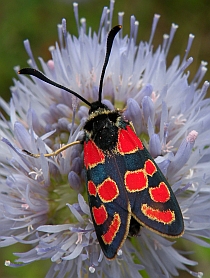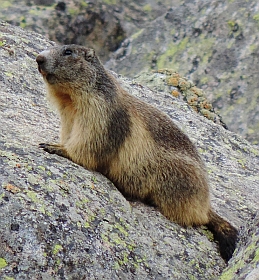The region of La Cerdanya is considered to be one of the richest regions for wildlife in the whole of the eastern Pyrenees. During the week, we will be based in the village of Prullans de Cerdanya, in the heart of the Segre Valley, which is bordered to the south by the Serra del Cadí (2,647 m) – a superb limestone ridge with a dramatic north-facing scarp – and to the north by a jumble of more rounded granite and shale peaks, reaching almost 3,000m and backing onto the independent state of Andorra. 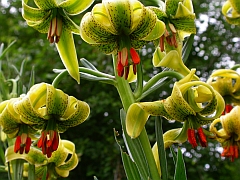 Pyrenean Lily Lilium pyrenaicum
© Teresa Farino
Pyrenean Lily Lilium pyrenaicum
© Teresa Farino
The valley hosts a mosaic of deciduous, coniferous and evergreen Mediterranean forests, dry haymeadows, water meadows and alpine rock-gardens on both limestone and granitic rocks. Together these support an incredibly diverse flora and fauna. For the botanist, the main attraction lies in the superbly rich flora found on the limestone of the Cadí ridge. High-level rock-gardens and screes here are studded with Narcissus-flowered Anemone, Parnassus-leaved Buttercup, Mountain Avens, the exquisite Ramonda, Pyrenean and Southern Gentians, Pyrenean Bellflowers, several species of rock-jasmine and a host of saxifrages, notably Reddish, Blue and Pyrenean. By contrast, the damp, acid haymeadows and mountain pine woodlands of the northern flank of the valley are home to gems such as the pale-yellow pasque flower Pulsatilla alpina ssp. apiifolia, Alpenrose, Great Yellow Gentian and its congener Gentiana burseri, Spiked Rampion and White False Helleborine. Peatbogs here literally teem with Lammergeiers and Golden Eagles soar above the sheer mountain crags, while Alpine Accentor, Wheatear, Rock Thrush, Water Pipit and Alpine Chough are the commonest passerines of the high rock-gardens and pastures. The conifer forests harbour Ring Ouzel, Goldcrest, Treecreeper, Crested Tit, Citril Finch and Crossbill, and if real fortune favours us we may see one or more of the highly elusive trio of Tengmalm's Owl, Black Woodpecker or the Pyrenean subspecies of Capercaillie. The mosaic of mixed woodland, pastures and meadows at middle altitudes provides a perfect habitat for Red-backed, Southern Grey and Woodchat Shrikes, Whinchat and Rock and Ortolan Buntings, while the valley bottom hosts Stone Curlew, Bee-eater and Golden Orioles. Small groups of Isard (Pyrenean Chamois) inhabit crags above the tree-line in the limestone massifs, while noisy Alpine Marmots occur mainly among the granite boulder chokes on the north side of the valley. 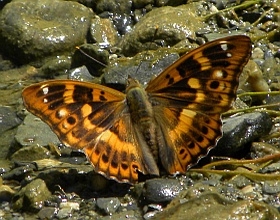 Lesser Purple Emperor
Lesser Purple EmperorApature ilia f. clytie © Teresa Farino A staggering variety of butterflies can be found in La Cerdanya in early summer, when it is perfectly possible to see more than 50 species in a single day. Of the 130-plus species that have been recorded here, over thirty are lycaenids, including such striking creatures as White-letter, Blue-spot and Sloe Hairstreaks, Scarce, Purple-shot and Purple-edged Coppers, and Large, Provençal Short-tailed, Glandon, Amanda's, Chapman's, Eros, Damon and Ripart's Anomalous Blues. More than 20 species of fritillaries grace the haymeadows and alpine pastures of the park, notably rarities such as Shepherd's, Mountain and Bog Fritillaries, with eleven species of ringlet (Erebia spp.) also known to occur here. Other eye-catching butterflies on the wing in late June might include Apollo, Clouded Apollo, Map Butterfly, Camberwell Beauty, Large Tortoiseshell, Lesser Purple Emperor, White and Southern White Admirals and Great Banded Grayling. Perhaps of greatest significance, however, are the highly localized colonies of the Mountain Alcon Blue, whose caterpillars feed exclusively on the flowers and young fruits of the Cross Gentian. The region holds a wealth of other wildlife, including reptiles such as Ocellated and Catalonian Wall Lizards, Western Whip and Viperine Snakes and Asp Viper, ten species of amphibians, the most notable of which is the Pyrenean Brook Newt, and a number of striking burnet moths: Scotch, Transparent, Crepuscular and Merry, to name but a few. A good selection of damselflies and dragonflies is also on offer, including Blue-eye, Spearhead and Mediterranean Bluets, Western Willow Spreadwing and Beautiful Demoiselle, plus Yellow-winged Darter, Black-tailed and Southern Skimmers and Common Goldenring. "Thank you so much for a lovely, enjoyable and informative week in the Catalan Pyrenees. It was wonderful and a real pleasure to be in your company." Dudley & Jean C. June 2009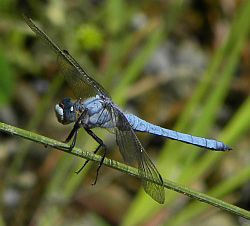 Southern Skimmer Orthetrum brunneum
© Teresa Farino
Southern Skimmer Orthetrum brunneum
© Teresa Farino
Wildlife of the Catalan PyreneesLeader: Teresa Farino 2018 Dates: Wednesday 20 June – Wednesday 27 June Price: 1,480€, including half-board, en suite accommodation at the comfortable Hotel Muntanya, picnic lunches, hired minibus transport throughout, all entry fees and the services of the leader. A single-room supplement of 150€ is applicable. Although the cost of the tour is given in euros, clients may pay in sterling, the exchange rate to be calculated at the time of payment using www.oanda.com This is a land-based tour. Flights and travel insurance (obligatory) are the responsibility of the client.  Ramonda Ramonda myconi© Teresa Farino Ramonda Ramonda myconi© Teresa Farino
Pick-up details: Ideally I will be collecting clients from Barcelona airport before 15.00 on 20 June in order to give us time for a leisurely drive to Prullans before dinner. Many operators – both scheduled and low-cost – fly to Barcelona from the UK, and all that we ask is that you select a flight that arrives before this time, otherwise you might have to arrange your own transfer the hotel. On 27 June, we will not be arriving back at Barcelona airport before 13.00, so please make sure that your selected flight does not depart before 15.00. Alternatively, those travelling to the Catalan Pyrenees independently can arrange to meet the group at the hotel on the first evening. Group size: maximum 8 participants. Booking information:
please contact Teresa Farino for further details and a booking form, or if you have any queries about this tour.
"Thanks for a lovely holiday in the Spanish Pyrenees. We saw lots of wildlife – butterflies, fantastic flowers, lizards, etc. The hotel was lovely, the food good, the day trips brilliant and the weather was pretty good too!" Janet & Chris P. July 2014 |
|  White-letter Hairstreak White-letter Hairstreak Satyrium w-album© Teresa Farino Related information:Catalan Pyrenees trip report 2011Catalan Pyrenees Botanical Report 2005 Read about Teresa Farino Wildlife holidays and natural history tours in Spain & Portugal |
|||||||||||||||||||||||||||||||||||
|
|||||||||||||||||||||||||||||||||||||


